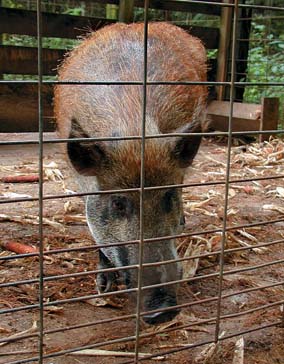The Root Of The Problem – Wild Hog Population on the Rise

Alabama’s landscape in and around river bottom areas is changing. One of nature’s less beautiful species is at the root of the problem–literally.Wild hogs, with their long tusks and rough, hairy backs, are increasing in number in many areas of the state, particularly near rivers and other waterways. While the animals are hunted for sport, they have an extremely fast reproductive rate that’s hard to control, so hunting alone doesn’t work well in controlling the population.Dickie Williams of Monroe County knows first hand the damage wild hogs can cause. He and his family have about 7,000 acres along the Alabama River that is home to hundreds, possibly thousands, of wild hogs.”I can remember there being wild hogs around our farm when I was a young boy,” said the 67-year-old pharmacist. “But it was different back then. Most of those hogs were just domestic hogs that had escaped or that people had turned loose. They were mean, and I can remember getting run up a tree by one of them when I was squirrel hunting. But then hunters brought in some Russian boars (also referred to by some as European boars) for sport hunting, and that’s when the numbers began to get out of control.”Hogs have a voracious appetite, and as omnivores, they eat just about anything that doesn’t eat them first. They don’t really have a serious natural predator, and when you combine that with a fast reproductive rate, a male and female can expand to 120 hogs in just two years.There’s a saying among those who are familiar with wild hogs–“When four or five are born in a litter, seven or eight usually survive.” A female hog can have her first litter after she is seven or eight months old, and she can have two litters a year of four or more pigs.Hogs can destroy a row crop, tear up roads and fields, and they are a real threat to native wildlife, according to Frank Boyd, state director for USDA Wildlife Services located at Auburn University.”Wild hogs are a growing problem and have been for several years,” Boyd said, “but the last five or 10 years we’ve really seen a big increase.”There are three types of wild hogs in Alabama, Boyd said. There are domestic hogs that have gone wild, some European wild hogs and a cross of the two.Wild hogs are well established in at least 52 counties in Alabama, according to a May 2001 study released by James B. Armstrong and M. K. Causey.Armstrong is an associate professor at Auburn University and is the Extension specialist for forestry and wildlife services. He said while some hunters really enjoy bagging a big boar, the tusked animals pose a serious threat to the natural habitat.”Based on the trends we’re seeing right now, their population is going to continue to increase,” Armstrong said. “Habitat destruction is probably the most serious threat because they eat the same things that wild deer and turkey do. Wild hogs also root up fields to the point that it’s very difficult to even drive a tractor across it. They also can destroy roads by rooting out holes that are two-three feet deep.”Row crop farmers in several areas of the state have reported severe damage caused by wild hogs. Peanut farmers have reported cases where hogs have wrecked a recently planted field by rooting up the seeds. Cornfields also are among the frequent casualties in areas where wild hog populations have exploded.”We can’t even consider growing corn on our farm anymore,” Williams said. “I’ve seen fields that look like a truck was driven through it after the hogs finished with it.”Williams said feral hogs were plentiful along the Alabama River in the southwestern area of the state until the 1950s when a cholera outbreak wiped out the entire population. Then in the 1960s, a group of hunters introduced a strand of Russian hogs and turned them out for sport hunting.”The herds in Monroe and surrounding counties have reached an alarming population rate,” Williams said. “They root up pine seedlings, corn fields, pasture, cotton fields and any other place they inhabit. They compete with deer, turkey and squirrels for the acorn supply. It’s impossible to grow chufas for turkey without the hogs destroying the patches, sometimes as quickly as overnight. We had a brown top millet and proso millet patch completely destroyed by the hogs in two days. I’ve even seen hogs come into a patch where deer were feeding and the deer ran out.”At his pharmacy in Monroeville, Williams has the tusks of some huge boars killed in his home county. He said he uses dogs to catch hogs on his farm. He does eat the meat, but he gives a lot of the hogs to his friends as well. In some areas, landowners use traps to catch the hogs, but Williams said it’s important to know that wild hogs can’t legally be released into areas where they don’t already exist.Feral hogs are classified as a game animal in Alabama, but there is no closed season and no bag limit. Because of the hogs’ destructive nature, the Alabama Department of Conservation and Natural Resources has a new program to help hunters and landowners control wild hogs. The animals can be hunted over bait during daylight hours between May 1 and Sept. 1, but the program requires a survey to be filled out at the end of the season showing the number of days hunted, shots fired, hogs harvested, seen, etc. More information is available from the Alabama Department of Conservation and Natural Resources or from any Alabama game warden.
